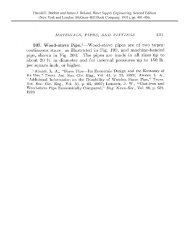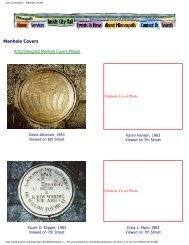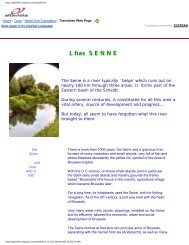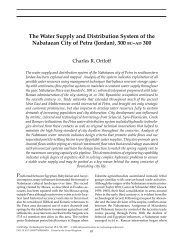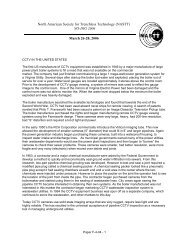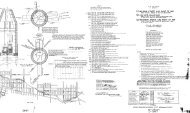A True Test of Sustainability
A True Test of Sustainability
A True Test of Sustainability
Create successful ePaper yourself
Turn your PDF publications into a flip-book with our unique Google optimized e-Paper software.
Wright Water Engineers<br />
clay. The stone lining also would have minimized<br />
maintenance requirements. The canal is supported<br />
by terraces built on the steep slopes <strong>of</strong> Machu<br />
Picchu to resist sliding and settlement.<br />
Beauty <strong>of</strong> Fountains<br />
Machu Picchu’s canal leads to one <strong>of</strong> its urban<br />
focal points, a religious center with a succession<br />
<strong>of</strong> 16 fountains. The functionality and beauty <strong>of</strong><br />
the fountains make them a notable example <strong>of</strong><br />
pre-Colombian water resources development.<br />
The fountains were laid out to provide domestic<br />
water for the population, to enhance the urban<br />
environment, and as a manifestation <strong>of</strong> the power<br />
<strong>of</strong> the Inca ruler Pachacuti.<br />
There is a 26-m vertical drop between<br />
Fountain No. 1 and Fountain No. 16.<br />
Fountain No. 1 was installed adjacent to the<br />
doorway <strong>of</strong> the Inca ruler, providing him with the<br />
first opportunity to utilize the imported water<br />
supply. Fountain No. 3 is known as the Sacred<br />
Fountain because it is adjacent to a stone <strong>of</strong> adoration,<br />
a huaca, and the enigmatic window <strong>of</strong> the<br />
Temple <strong>of</strong> the Sun. The water flows in sequence,<br />
from Fountain No. 4 through 12 more fountains<br />
to Fountain No. 16.<br />
Detailed field instrument surveys were conducted,<br />
such as hydraulic flow tests, measurements<br />
<strong>of</strong> the fountain structures, and measurements<br />
<strong>of</strong> channel and outlet sizes. A small orifice<br />
outlet 3.8 cm in diameter measured in the basin<br />
<strong>of</strong> Fountain No. 4 would have limited the maximum<br />
fountain system flow capacity to 100 L/min.<br />
However, the individual fountains, based on flow<br />
tests, were designed to operate optimally with<br />
a flow <strong>of</strong> about 25 L/min to fill the common Inca<br />
water jug, known as the aryballo. Field testing <strong>of</strong><br />
the fountain hydraulic characteristics showed<br />
that the fountains would operate satisfactorily<br />
at flows as low as 10 L/min.<br />
A common form, function, and layout are<br />
shared by all 16 fountains. Each has a carefully<br />
cut stone channel or conduit that delivers water<br />
at or near the top <strong>of</strong> the fountain enclosure that<br />
provided a degree <strong>of</strong> privacy and a sharp-edged<br />
or lipped rectangular fountain spout that created<br />
a falling jet into a cut-stone basin at the bottom <strong>of</strong><br />
the enclosure. Except for Fountain No. 16, each<br />
fountain can be reached via common stairways<br />
and walkways. The water in each fountain is<br />
channeled to the next fountain through a 3.8 to<br />
5.0-cm-diameter circular cut-stone drain outlet.<br />
Delivery <strong>of</strong> water<br />
from upper Tipon<br />
terraces to lower<br />
terraces was<br />
accomplished<br />
using vertical<br />
drop structures<br />
inset into the<br />
terrace stonework.<br />
© 2008 Water Environment & Technology All rights reserved<br />
s e p t e m b e r 2 0 0 8<br />
83



